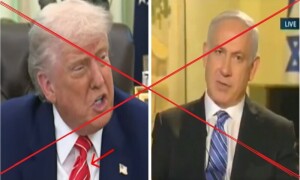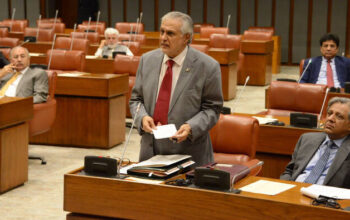By Staff Reporter
ISLAMABAD: Pakistan is set to slash its overall tariff regime by more than 4% over the next five years as part of a bold reform package aimed at turbocharging exports and pivoting the nation toward an export-led growth model, Finance Minister Muhammad Aurangzeb said on Wednesday.
The move, tied to a $7 billion International Monetary Fund program approved last year, marks a dramatic shift from decades of protectionism, with the government already scrapping additional customs duties on 4,000 tariff lines and trimming them on 2,700 more out of a total 7,000.
The tariff overhaul headlines the National Tariff Policy 2025–30, which will collapse the customs structure into four duty slabs ranging from 0% to 15%, with 15% as the maximum rate.
Aurangzeb said the policy will also abolish additional customs duties, regulatory duties, and the fifth schedule of the Customs Act, 1969, streamlining a system long criticized for stifling trade.
“First, the goal is to change the overall protected regime. When you lower protection and dismantle walls around it, you improve the economy’s resource allocation, better capital allocation, better human resource allocation, so that’s the overall macroeconomic framework,” the minister told reporters at a post-budget press conference in Islamabad.
The World Bank projects that once implemented, these reforms will drop Pakistan’s average tariff to the lowest in the region, a point Aurangzeb underscored in his budget speech unveiling the Rs17.6 trillion federal budget for FY2025–26.
Aurangzeb cast the initiative as Pakistan’s “East Asia moment,” drawing parallels to the export-driven booms of nations like South Korea and Taiwan. “This I am talking about year one. We will take it towards a more than 4 percent reduction in the overall tariff regime in Pakistan,” he said, stressing that the phased cuts, kicking off this year, aim to break the cycle of balance-of-payments crises that have repeatedly hammered the economy. “So that when we go toward growth we don’t get into the dollar situation, we don’t get into a balance of payment problem.”
Exports climbed more than 6% to $26.9 billion from July to April, against imports of $48.3 billion, up 8% in the same period, offering early signs of traction. “People ask us that the revenue will decline but if we have to take this country forward towards an export-led discussion […] I want to go into the details of the steps we have taken,” he added, noting that the 2,700 tariff lines with reduced duties target raw materials vital for exporters.
The tariff cuts arrive amid a high-stakes fiscal juggling act. Aurangzeb warned that if parliament doesn’t pass enabling legislation for Rs312 billion in new tax measures, the government may slap on an additional Rs400–500 billion in taxes. “The parliament should help us in enabling amendments so we don’t opt for additional measures to stop the leakages in the system,” he said.
Enforcement has already clawed back Rs400 billion this fiscal year, a feat he touted as proof of credibility. “We now have the credibility and trust internally and externally that we can do the enforcement,” Aurangzeb said.
Finance Secretary Imdadullah Bosal, speaking at the same event, confirmed that budget figures, including Rs389 billion in IMF-approved additional taxes for FY26, are “locked” with the fund, which has pushed for fiscal consolidation, debt rationalization, and revenue mobilization.
Despite the squeeze, the budget carves out relief: a 10% salary hike and 7% pension increase for federal employees, pegged to easing inflation. “If we are saying the inflation is declining, similarly, the salary or pension has to be benchmarked with inflation,” Aurangzeb explained.
Businesses get a 0.5% super tax cut, while real estate and construction incentives aim to jolt those sectors back to life. “The federal government, whatever it is giving, is from the loans that we are taking because we start [the new year] with a deficit,” he said, laying bare the fiscal tightrope.
Bosal noted current expenditure growth has slowed to under 2% in FY25 from 26% in FY24, a shift Aurangzeb called “our response back to those people who are paying taxes in this country.”
Agriculture, a linchpin of the economy, gets targeted support. Aurangzeb said an additional tax on fertilizers and pesticides was nixed after IMF talks, given their role as “critical input into agriculture.”
He vowed to shrink the influence of middlemen and ramp up financing for small farmers. “This is a step in the right direction,” he said.
For the digital economy, FBR Inland Revenue member Dr. Najeeb Ahmad detailed tiered e-commerce taxes: 0.25% for items under Rs20,000, like electronics, and 2% for high-value goods like boutique clothing. “We did not follow previous policies that everyone should suffer under the same category,” Ahmad said.
Aurangzeb spotlighted opportunities for the youth, particularly freelancers and coders. “The coders are now earning $8 to 10 per hour; we hope they reach $100 per hour rate,” he said, calling on the private sector to lead.
Energy reforms also drew focus. FBR Chairman Langrial defended an 18% sales tax on imported solar panels to align with local assemblers.
“The payback period was two years, so we are ending these anomalies,” he said.
On the provincial front, Aurangzeb said the federal tax pool will channel a record Rs8.2 trillion to the provinces in FY26, with coordination baked into the National Fiscal Pact. “Everything will be done in consultation with provinces,” he pledged.
Reflecting on the broader shift, he added, “The things that had never been reversed before have now been put into reversal, but that’s not the eventual end state.”
Copyright © 2021 Independent Pakistan | All rights reserved




